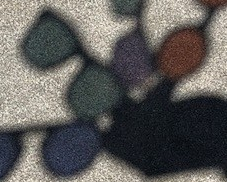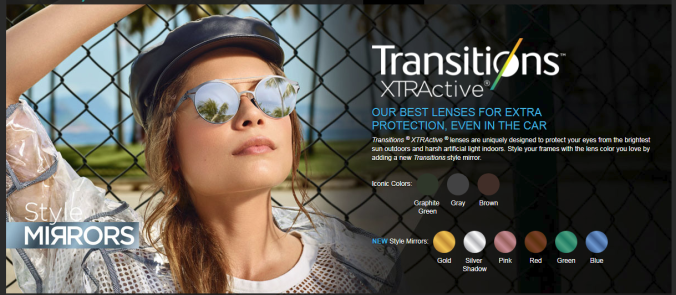 As always by Ric Peralta, The Optical Jedi
As always by Ric Peralta, The Optical Jedi
If you’ve been following my Instagram account, you’ll know I’ve been posting an awful lot about the new Transitions Style products. If you haven’t been following, go check it out now. I’ll wait for you before I review them…
…Now that you’re back…
Transitions has been a very successful product in the optical industry, since it launched back in the early 1990’s. It had some rough bits in the beginning, as they continued to improve the functionality of the photochromic molecules which made the lenses work. Since the early 2000’s the lens has made many inroads to prescription eyeglass wearers as the lenses have been able to change faster and faster with each passing year, as well as go darker outside and clearer indoors. For the level of comfort and convenience Transitions can provide, they can be an excellent fit for almost every patient.
But there is one key demographic they have always struggled to fully reach…the Millenials. The new Style line of products were developed specifically to reach this demographic, but they can be an excellent fit for other patients too.
What is a Photochromic Lens?
You may be asking yourself what exactly is a Photochromic lens anyway? Any lens which responds to exposure to light (or UV depending on the model) and changes it’s color, is a Photochromic lens. There are several brands which do this. Before the advent of Transitions branded lenses in the early 90’s, if a patient wanted to have a lens that got dark outside they had to wear a Glass lens, called PhotoGray. As the name implies the lens could only become a grey tint outside, and whiles it’s performance was pretty good for the time, the limitations of weight with a glass lens (almost twice the weight of standard CR-39 plastic), they were not an ideal fit for all patients. There were also limitations on what lens designs could be purchased in PhotoGray.
Transitions was the first readily available mass marketed plastic lens which could change from light to dark. In it’s earliest days, it was about 10-15% indoors and about 60-65% outside. It was also highly temperature dependent. In the ensuing 30 years the technology has reached the point where it is virtually clear indoors (think more like 1-5% tint) and in direct, bright sun can be as dark as 80% tint.

Transitions Signature vs. Transitions XtraActive
It is not commonly known, even amongst current Photochromic wearers, that there is more than one version of Transitions available.
Far and away, the most popular solution is Transitions Signature, which is a lens that is only responsive to UV light. In practice, this means the lenses only get dark when they are exposed to direct UV light (i.e. only when they are physically outdoors). The advantage for this photochromic style is that the lenses are clear indoors, the disadvantage is that they don’t change more than maybe 10% in the car (the safety film of your windshield blocks most UV). This is most popular because it will be clear indoors…and many opticians won’t even mention other options.
Transitions XtraActive is responsive to any all light. The advantages of this lens are that it will change inside the car (to approximately 50% tint) and will get darker (closer to 85% tint) outside. In part, because they respond to ANY light, they are never clear indoors. There is always a little residual tint and it is based on how much ambient light you are experiencing. For this reason, the XtraActive lens can be an excellent choice to patients who have a high level of light sensitivity. My wife has been wearing this lens technology almost exclusively for as long as I’ve known her since she is a photosensitive teacher working under bright fluorescent lighting all day long.
There are a couple of other niche versions of Transitions, including Vantage and Drivewear, both are Transitions lenses which integrate Polarization. However each has neither is a good first pair solution. Drivewear is a full time sunglass, which just changes how dark the sunglass gets. Vantage is a lens that starts “clear” and becomes a polarized sunglass, however the density of the tint comes much closer to matching the original Transitions from the early 90’s (never quite light or dark enough for the situation).

- The Family of Transitions Products, including the Vantage and the Drivewear. While these lenses can make a lot of sense for some patients, they are more niche.
Transitions has launched new Signature and XtraActive solutions this month.
New Transitions Signature Styles

- New Transitions Style Colors (from left to right: Sapphire, Emerald, Amethyst, Amber)
Almost exactly one month ago Transitions launched a whole new collection of Signature Colors, they’ve termed “Style Colors” and they are pretty outstanding in their look. The new colors are, Amber, Emerald, Sapphire, and Amethyst. And these names are very evocative of the colors they represent.

New Transitions Style Colors (from top to bottom: Sapphire, Emerald, Amethyst, Amber)

- Activated Sapphire Style Colors, and how it looks viewing the world through that color
Unfortunately, at this stage the new Style Colors are not available on most insurances. Make sure and ask your Optician if they are available through your plan yet.
New Transitions XtraActive Style Mirrors

The New Style Mirrors family of Transitions products are a very different approach to the classic Photochromic lens. These lenses were designed from the outset as a second pair solution, something with a high level of style. These lenses are wearable indoors with a very slight “flash” mirror treatment. As soon as they have light exposure they start to darken and the mirror becomes more prominent.

- Xtra Active Style Mirror in Gold with Brown Photochromic lens underneath – Fully Activated

- The Xtra Active Style Mirror in Green with a Grey base underneath
I have a pair and love them…as a second pair. They can be incredibly convenient and comfortable if you are going in and out of doors a lot. They look great in pretty much every environment, HOWEVER, there is a significant amount of glare that is noticeable in all situations. And night vision is noticeably diminished because of that additional glare. I can still drive. I still feel safe, but I am annoyed by the additional glare.
Take Away
The Style collection was created to appeal to the Millenial Generation, but it can have a much broader appeal to the general populace. It’s greatest limitation for the Generation X and older at this stage is the relatively limited progressive lens designs available.
While the products are not available through most insurances yet, they are available in multiple thin lens materials to fit many prescription types. The Style Mirrors are not idea for everyday use, but can be a truly enjoyable second pair. And they certainly catch the eye and garner comments and compliments.
The Style family of products from Transitions really do look even better in person than the photos above. See your local optician (or me if I’m local) and see the products for yourself.
If you have any further questions, or if you would like to suggest a topic, please contact me at any time. I’m here to be your Guide to the Mysteries of Eyewear…


Pingback: The Pitfalls of Online Glasses: The Review | THE OPTICAL JEDI: A GUIDE TO THE MYSTERIES OF GLASSES
Re:Style Mirror – yes to the glare. Can’t coat with any Crizal. In-house backside A/R only.
Gold is shinier than red, though the red is nice and subtle against a brown base.
Amethyst on order. Really like the look of amber, but will have to wait.
Thank you as always for some excellent knowledge and pics to gowith..
LikeLike
My absolute pleasure. Also it’s actually not an in-house glare coating. But it’s not Crizal either. Even my Essilor connections haven’t been able to confirm what they are doing. Because it is back side UV filtering. And it does have a TD2 style slick coating. Pen markings can be removed without any solutions.
LikeLike
Pingback: More on Blue Light Filtration: Eyzen+ | THE OPTICAL JEDI: A GUIDE TO THE MYSTERIES OF GLASSES
Pingback: Product Review: Varilux X Design | THE OPTICAL JEDI: A GUIDE TO THE MYSTERIES OF GLASSES
Pingback: Importance of Children’s Eye Exams | THE OPTICAL JEDI: A GUIDE TO THE MYSTERIES OF GLASSES
Pingback: Common Misconceptions | THE OPTICAL JEDI: A GUIDE TO THE MYSTERIES OF GLASSES
thanks for the information. as a millennial who used transitions years ago (probably gen 4?), i stopped because they never seemed to get dark enough in full brightness, particularly in the heat, and indoors, they took on a slightly yellow tinge after about a year.
i just picked up some gen 8 lenses (though i have no way to prove that other than the vendor telling me so), and they seem to get dark very quickly outdoors, and the clearing period is at least acceptable when i step back inside.
LikeLike
Pingback: A Comparison Review of Computer Progressives | THE OPTICAL JEDI: A GUIDE TO THE MYSTERIES OF GLASSES